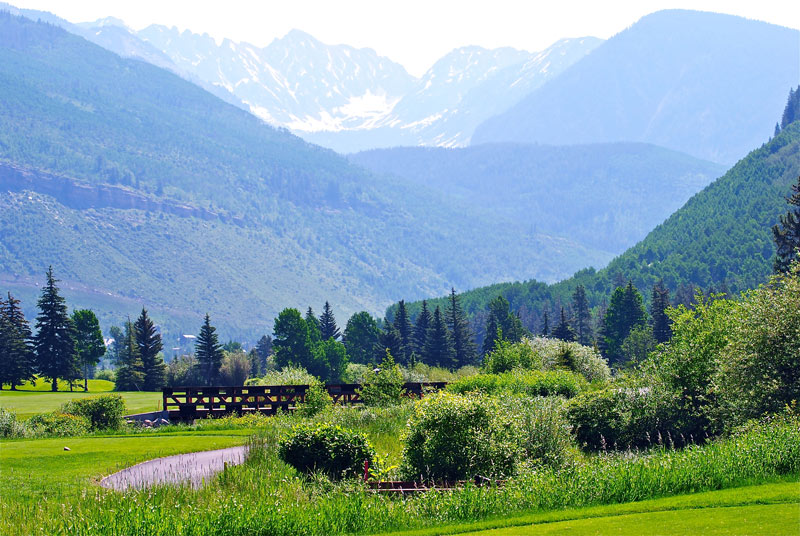
Vail Golf Club is one of the longest-running Certified Audubon Cooperative Sanctuaries. Photo by Pamela C. Smith
Nestled along the Gore Mountain Range in north-central Colorado, Vail Golf Club offers outstanding mountain golf to local and destination golfers alike. Even though the season is relatively short (May through October), Vail GC accommodates upward of 25,000 rounds each year. The club is open to the public, and its player experience is spectacular, from the challenging 6,786 yards to its dramatic mountain views, with the thin mountain air making every drive heroic. Located in the heart of Colorado ski country, Vail GC provides winter recreation for cross-country skiers and snowshoers during the off-season.
Vail GC earned distinction in 2015 by becoming recertified as an Audubon Cooperative Sanctuary. Designed by Ben Krueger, the course was built in 1962 and has been a member of the Audubon Cooperative Sanctuary Program (ACSP) since 1998, making it one of the longest-running certified cooperative sanctuaries.
The Water Quality Management portion of the ACSP recertification was a natural for Vail GC. The property runs through the Gore Creek river valley, which is located within the Eagle River watershed. The Clean Water Act lists Gore Creek as “impaired,” meaning it fails to meet certain water-quality standards. In this case, pressure from urban and commercial runoff has led to the pollution of this mountain stream, which has compromised populations of insects that are a food source for trout.
Vail GC goes to extraordinary measures to have zero impact on this stream. GCSAA Class A superintendent Scott Todd, a 25-year association member, uses riparian buffer zones, hand spraying, stream bank stabilization, limited fertilizer applications and other BMPs as an integral part of daily maintenance. These efforts are put to the test via routine sampling, in which Todd has an independent consultant send water samples to Brookside Laboratories in May, July and September. The tests look for nitrate, nitrite nitrogen, ammonia nitrogen, phosphorous, dissolved solids and certain pesticides, such as 2,4-D, dicamba and iprodione. Todd says the tests typically show that water flowing out of the golf course is cleaner than it was when it entered. The course’s water features act as stormwater controls, removing harmful sediment and street runoff from the river system. This winter, Todd and staff are working with the local water district to test for pesticide indices within samples collected from wells on the property — to detect any issues with groundwater — in addition to the surface water testing.
Wildlife and Habitat Management is also a strong suit for Vail GC. Some of the Rocky Mountains’ most notable wildlife, such as bighorn sheep, brown bear, elk and moose, call the course home. Beaver dams are abundant and are naturally controlled by the harsh winters. Beavers can be a pest for developed land, but Todd says the animals are left alone to build their lodges and raise their young, and they’ve never presented a problem for the course outside of requiring that culvert grates be cleared regularly. Rainbow and brook trout can be easily spotted in the clear waters of Gore Creek as it winds through the boundaries of the golf course, and educational signs throughout the course inform visitors about these and other creatures native to the area.
Another key component to Vail GC’s success in the ACSP is its maintenance facility. Located out of the flood plain, the facility hits all the marks for Chemical Use Reduction and Safety. Oils and fuels are controlled by secondary containment. Pesticides are kept in storage lockers and at low inventories. Catch basins capture sediment and other contaminants before they can enter the watershed. Good housekeeping is evident throughout the entire operation, and the facility is a model for what is becoming the norm in golf maintenance setups.
Vail GC also shines in the ACSP’s Outreach and Education and Water Conservation categories. In a recent public meeting, Todd discussed the club’s initiatives to protect Gore Creek, explaining how stream bank stabilization projects reduce scouring and improve water quality. He also shared how the course is determined to eliminate chemical runoff by selective applications and steadfast use of buffer strips between turfgrass and water bodies. Hand watering, wetting agents and other cultural practices help keep water consumption to a minimum, and the club has a written drought management policy to ensure municipal needs are met while mitigating any permanent damage to turf. The club has had to restrict irrigation twice in the past four years when the flow of Gore Creek reached minimal levels that dictated decreases to roughs, landscape areas and the driving range. Had Gore Creek flow dropped to the next threshold level, fairways and tees would have seen irrigation reductions.
“Vail Golf Club is an excellent example of a course that fits well into their surrounding landscape, the beautiful Rocky Mountains,” says Tara Donadio, director of cooperative sanctuary programs at Audubon International. “The club has consistently shown good environmental stewardship over their 18 years in the ACSP, and we are proud to call them a certified member.”
Pamela C. Smith, CGCS, is an attorney and the director of agronomy for a large city. She is a 25-year member of GCSAA.